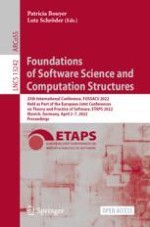Open Access 2022 | Open Access | Book

Foundations of Software Science and Computation Structures
25th International Conference, FOSSACS 2022, Held as Part of the European Joint Conferences on Theory and Practice of Software, ETAPS 2022, Munich, Germany, April 2–7, 2022, Proceedings
Editors: Prof. Patricia Bouyer, Lutz Schröder
Publisher: Springer International Publishing
Book Series : Lecture Notes in Computer Science

